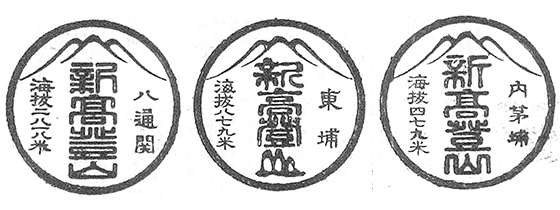At first glance, stamp collating probably doesn’t seem like a suitable topic to be covered by a site dedicated to hiking. However, in addition to the fact that there are a couple of long-distance trails with passports for collecting stamps, the history of travellers in Taiwan collecting commemorative stamps is quite deeply intertwined with the county’s history of mountaineering.
The very first commemorative stamp in Taiwan was created in 1922 to mark an ascent to the highest peak in Taiwan. The stamp was fashioned by an off-duty Japanese stamp manufacturer surnamed Matsuda (松田) in the downtime during an expedition to climb Jade Mountain. However, the appearance of Mr Matsuda’s stamp has been long since lost to history.

A few years later, some more stamps were created by a Shigeju Aoki (青木繁) to commemorate the fact that 33 students from Taipei First Girl’s High School summited Jade Mountain (three of them are shown above). Shigeju Aoki, who shares his name with a more famous painter, is more commonly remembered as being one of the first people to write about Taiwan’s natural environment. The three stamps above all feature the Japanese name for Jade Mountain “Mount Niitake” (新高登山, which means New High Mountain—a reference to the fact that Jade Mountain is 176 metres taller than Mount Fuji, the prior highest mountain in the Japanese Empire). And setting the tone for just how thoughtful and considered these stamps would go on to be, the character for mountain (山) is rendered in three unique ways—representing the changing faces that a mountain can present to hikers.
From these beginnings, interest in commemorative stamps spread, and various agencies, companies, temples, and events got in on the action. This was no doubt influenced by the already strong tradition of stamping in Japan (a tradition that has continued to grow and expand over the years).
These days, you can find stamps in places all throughout Taiwan. The MRT and railway stamps seem to be the most popular, but you can also find them at various tourist sites and even a couple of hiking trails. Follow the links below to find more information.






